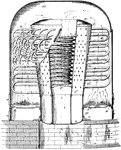Clipart tagged: ‘heat energy’

Mechanical Drawing of a Metal Cylinder
"Steam is admitted under pressure for a boiler into a metal cylinder behind a piston, as represented…

Steam Boiler Engine
This design with natural induction used for marine purposes was the popular “Scotch” marine boiler,…

Thermodynamics Apparatus Showing the Relationship between the First and Second Principals
"The falling weights EE turned a paddle-wheel stirrer inside the cylindrical vessel G, which was filled…